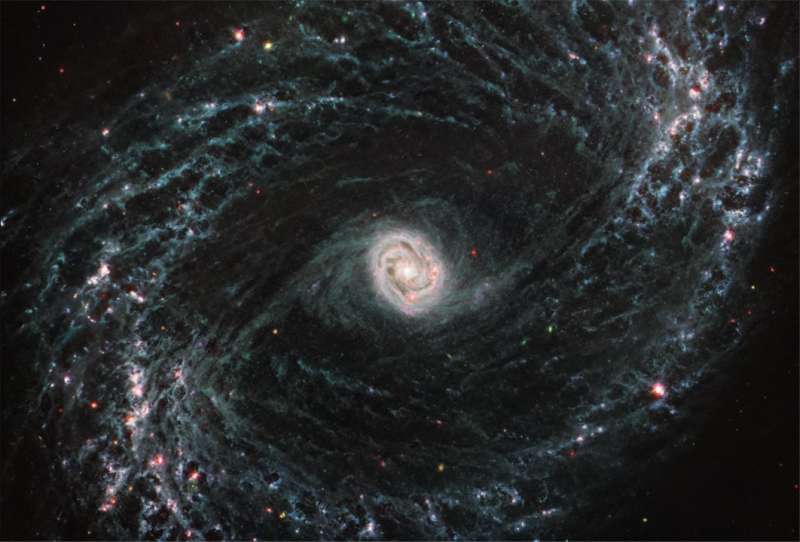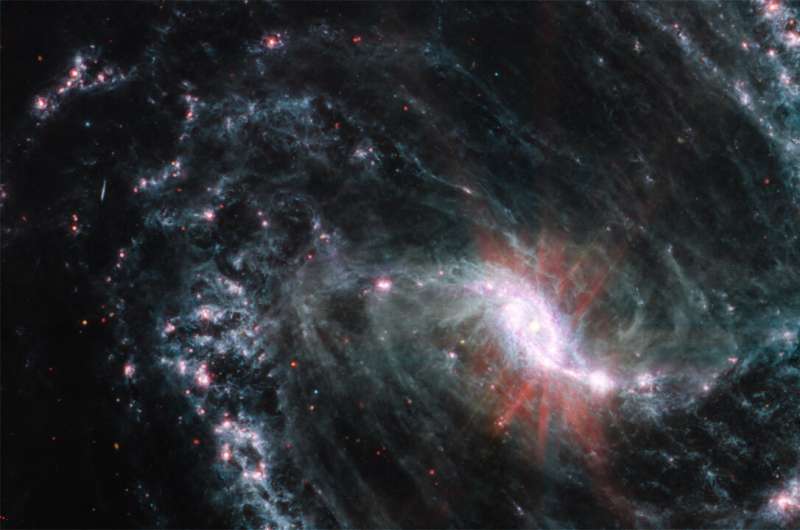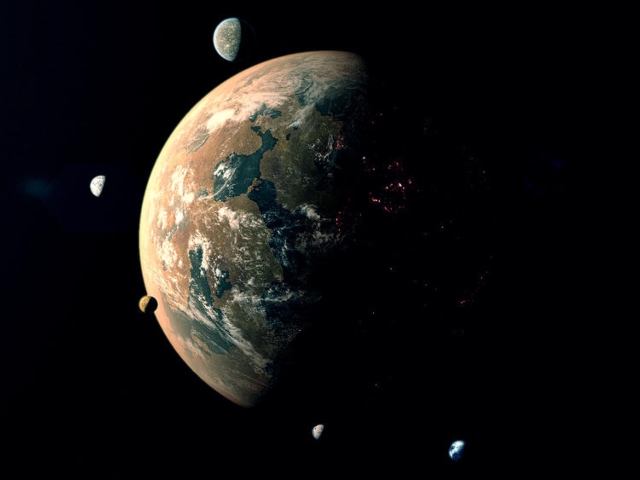Science
NASA’s Webb telescope reveals intricate networks of gas, dust in nearby galaxies

|
|
Researchers using NASA’s James Webb Space Telescope are getting their first look at star formation, gas, and dust in nearby galaxies with unprecedented resolution at infrared wavelengths. The data has enabled an initial collection of 21 research papers which provide new insight into how some of the smallest-scale processes in our universe—the beginnings of star formation—impact the evolution of the largest objects in our cosmos: galaxies.
The largest survey of nearby galaxies in Webb’s first year of science operations is being carried out by the Physics at High Angular resolution in Nearby Galaxies (PHANGS) collaboration, involving more than 100 researchers from around the globe. The Webb observations are led by Janice Lee, Gemini Observatory chief scientist at the National Science Foundation’s NOIRLab and affiliate astronomer at the University of Arizona in Tucson.
The team is studying a diverse sample of 19 spiral galaxies, and in Webb’s first few months of science operations, observations of five of those targets—M74, NGC 7496, IC 5332, NGC 1365, and NGC 1433—have taken place. The results are already astounding astronomers.
“The clarity with which we are seeing the fine structure certainly caught us by surprise,” said team member David Thilker of Johns Hopkins University in Baltimore, Maryland.
“We are directly seeing how the energy from the formation of young stars affects the gas around them, and it’s just remarkable,” said team member Erik Rosolowsky of the University of Alberta, Canada.
The images from Webb’s Mid-Infrared Instrument (MIRI) reveal the presence of a network of highly structured features within these galaxies—glowing cavities of dust and huge cavernous bubbles of gas that line the spiral arms. In some regions of the nearby galaxies observed, this web of features appears built from both individual and overlapping shells and bubbles where young stars are releasing energy.
“Areas which are completely dark in Hubble imaging light up in exquisite detail in these new infrared images, allowing us to study how the dust in the interstellar medium has absorbed the light from forming stars and emitted it back out in the infrared, illuminating an intricate network of gas and dust,” said team member Karin Sandstrom of the University of California, San Diego.
The high-resolution imaging needed to study these structures has long evaded astronomers—until Webb came into the picture.


“The PHANGS team has spent years observing these galaxies at optical, radio, and ultraviolent wavelengths using NASA’s Hubble Space Telescope, the Atacama Large Millimeter/Submillimeter Array, and the Very Large Telescope’s Multi Unit Spectroscopic Explorer,” added team member Adam Leroy of the Ohio State University. “But the earliest stages of a star’s life cycle have remained out of view because the process is enshrouded within gas and dust clouds.”
Webb’s powerful infrared capabilities can pierce through the dust to connect the missing puzzle pieces.
For example, specific wavelengths observable by MIRI (7.7 and 11.3 microns) and Webb’s Near-Infrared Camera (3.3 microns) are sensitive to emission from polycyclic aromatic hydrocarbons, which play a critical role in the formation of stars and planets. These molecules were detected by Webb in the first observations by the PHANGS program.
Studying these interactions at the finest scale can help provide insights into the larger picture of how galaxies have evolved over time.
“Because these observations are taken as part of what’s called a treasury program, they are available to the public as they are observed and received on Earth,” said Eva Schinnerer of the Max Planck Institute for Astronomy in Heidelberg, Germany, and leader of the PHANGS collaboration.
The PHANGS team will work to create and release data sets that align Webb’s data to each of the complementary data sets obtained previously from the other observatories, to help accelerate discovery by the broader astronomical community.
“Thanks to the telescope’s resolution, for the first time we can conduct a complete census of star formation, and take inventories of the interstellar medium bubble structures in nearby galaxies beyond the Local Group,” Lee said. “That census will help us understand how star formation and its feedback imprint themselves on the interstellar medium, then give rise to the next generation of stars, or how it actually impedes the next generation of stars from being formed.”
The team’s initial findings, composed of 21 individual studies, were recently published in a special focus issue of The Astrophysical Journal Letters.
More information:
Results: iopscience.iop.org/collections … S-JWST-First-Results (multiple DOIs)
Provided by
NASA
Citation:
NASA’s Webb telescope reveals intricate networks of gas, dust in nearby galaxies (2023, February 16)
retrieved 16 February 2023
from https://phys.org/news/2023-02-nasa-webb-telescope-reveals-intricate.html
This document is subject to copyright. Apart from any fair dealing for the purpose of private study or research, no
part may be reproduced without the written permission. The content is provided for information purposes only.





Science
Dragonfly: NASA greenlights most important mission of the century – Earth.com


In a remarkable development, NASA has given the green light to the Dragonfly mission, a revolutionary rotorcraft designed to investigate the complex chemistry of Saturn‘s moon Titan.
This confirmation allows the mission to proceed with the final design, construction, and testing of the spacecraft and its scientific instruments.
Deciphering the prebiotic chemistry on Titan
The Dragonfly mission, led by Dr. Melissa Trainer of NASA’s Goddard Space Flight Center, will carry a cutting-edge instrument called the Dragonfly Mass Spectrometer (DraMS).
This powerful tool will help scientists delve into the intricate chemistry at work on Titan, potentially shedding light on the chemical processes that led to the emergence of life on Earth, known as prebiotic chemistry.
“We want to know if the type of chemistry that could be important for early pre-biochemical systems on Earth is taking place on Titan,” explains Dr. Trainer, a planetary scientist and astrobiologist specializing in Titan.
Titan: Dragonfly’s target
Titan, the largest moon of Saturn, is shrouded in a dense nitrogen-rich atmosphere, bears a striking resemblance to Earth in many ways. With a diameter of 5,150 kilometers, Titan is the second-largest moon in our solar system, surpassed only by Jupiter’s Ganymede.
Dense atmosphere and unique climate
One of Titan’s most distinctive features is its thick atmosphere, which is composed primarily of nitrogen and methane. This dense atmosphere creates a surface pressure 1.5 times higher than Earth’s, making it the only moon in our solar system with a substantial atmosphere.
The presence of methane in Titan’s atmosphere leads to a fascinating hydrological cycle, similar to Earth’s water cycle, but with methane as the primary liquid.
Titan’s surface is dotted with numerous lakes and seas of liquid hydrocarbons, predominantly methane and ethane. These liquid bodies, some of which are larger than the Great Lakes on Earth, are the result of Titan’s unique climate and atmospheric conditions.
The Cassini mission, which explored the Saturn system from 2004 to 2017, provided stunning images and data of these extraterrestrial lakes and seas.
Dragonfly mission to search Titan for prebiotic chemistry and life
The complex chemistry occurring on Titan’s surface and in its atmosphere has drawn significant attention from astrobiologists.
With its abundant organic compounds and the presence of liquid methane, Titan is considered a prime candidate for studying prebiotic chemistry and the potential for life to emerge in environments different from Earth.
Beneath Titan’s icy crust lies another intriguing feature: a global subsurface ocean of liquid water and ammonia. This ocean, which is believed to be salty and have a high pH, may potentially host microbial life.
The presence of this subsurface ocean, along with the unique chemistry on Titan’s surface, makes this moon a fascinating target for future exploration and scientific research.
Pushing the boundaries of rotorcraft exploration
Nicky Fox, associate administrator of the Science Mission Directorate at NASA Headquarters, emphasized the significance of the Dragonfly mission, stating, “Exploring Titan will push the boundaries of what we can do with rotorcraft outside of Earth.”
Titan’s unique characteristics, including its abundant complex carbon-rich chemistry, interior ocean, and past presence of liquid water on the surface, make it an ideal destination for studying prebiotic chemical processes and the potential habitability of an extraterrestrial environment.
Innovative design and cutting-edge technology
The Dragonfly robotic rotorcraft will leverage Titan’s low gravity and dense atmosphere to fly between different points of interest on the moon’s surface, spanning several miles apart.
This innovative approach allows the entire suite of instruments to be relocated to new sites once the previous one has been thoroughly explored, providing access to samples from diverse geological environments.
DraMS, developed by the same team responsible for the Sample Analysis at Mars (SAM) instrument suite aboard the Curiosity rover, will analyze surface samples using techniques tested on Mars.
Dr. Trainer emphasized the benefits of this heritage, stating, “This design has given us an instrument that’s very flexible, that can adapt to the different types of surface samples.”
Dragonfly mission challenges and funding
The Dragonfly mission successfully passed its Preliminary Design Review in early 2023. However, due to funding constraints, the mission was asked to develop an updated budget and schedule.
The revised plan, presented and conditionally approved in November 2023, hinged on the outcome of the fiscal year 2025 budget process.
With the release of the president’s fiscal year 2025 budget request, Dragonfly is now confirmed with a total lifecycle cost of $3.35 billion and a launch date set for July 2028.
This reflects a cost increase of approximately two times the initially proposed cost and a delay of more than two years from the original selection in 2019.
Despite the challenges posed by funding constraints, the COVID-19 pandemic, supply chain issues, and an in-depth design iteration, NASA remains committed to the Dragonfly mission.
Additional funding has been provided for a heavy-lift launch vehicle to shorten the mission’s cruise phase and compensate for the delayed arrival at Titan.
Rigorous testing and validation
To ensure the success of the Dragonfly mission, researchers on Earth have conducted extensive testing and validation of the designs and models for the nuclear-powered, car-sized drone.
The mission team has carried out test campaigns at NASA’s Langley Research Center, utilizing the Subsonic Tunnel and the Transonic Dynamics Tunnel (TDT) to validate computational fluid dynamics models and gather data under simulated Titan atmospheric conditions.
Ken Hibbard, Dragonfly mission systems engineer at APL, emphasized the importance of these tests, stating, “All of these tests feed into our Dragonfly Titan simulations and performance predictions.”
As the Dragonfly mission progresses, it marks a new era of exploration and scientific discovery. Dr. Trainer expressed her excitement, saying, “Dragonfly is a spectacular science mission with broad community interest, and we are excited to take the next steps on this mission.”
Turning science fiction into fact with the Dragonfly mission
In summary, the Dragonfly mission embodies the essence of human curiosity and the relentless pursuit of knowledge. As NASA prepares to send this revolutionary rotorcraft to the alien world of Titan, we stand on the brink of a new era of exploration and discovery.
With its innovative design, cutting-edge technology, and the unwavering dedication of the mission team, Dragonfly will unlock the secrets of prebiotic chemistry and shed light on the potential for life beyond Earth.
As we eagerly await the launch of this titanic mission, we can only imagine the wonders that await us on Saturn’s enigmatic moon. The Dragonfly mission is a testament to the indomitable human spirit and our boundless capacity to push the frontiers of knowledge.
In the words of Ken Hibbard, “With Dragonfly, we’re turning science fiction into exploration fact,” and that fact will undoubtedly inspire generations to come.
—–
Like what you read? Subscribe to our newsletter for engaging articles, exclusive content, and the latest updates.
Check us out on EarthSnap, a free app brought to you by Eric Ralls and Earth.com.
—–
Science
Marine plankton could act as alert in mass extinction event: UVic researcher – Langley Advance Times


A University of Victoria micropaleontologist found that marine plankton may act as an early alert system before a mass extinction occurs.
With help from collaborators at the University of Bristol and Harvard, Andy Fraass’ newest paper in the Nature journal shows that after an analysis of fossil records showed that plankton community structures change before a mass extinction event.
“One of the major findings of the paper was how communities respond to climate events in the past depends on the previous climate,” Fraass said in a news release. “That means that we need to spend a lot more effort understanding recent communities, prior to industrialization. We need to work out what community structure looked like before human-caused climate change, and what has happened since, to do a better job at predicting what will happen in the future.”
According to the release, the fossil record is the most complete and extensive archive of biological changes available to science and by applying advanced computational analyses to the archive, researchers were able to detail the global community structure of the oceans dating back millions of years.
A key finding of the study was that during the “early eocene climatic optimum,” a geological era with sustained high global temperatures equivalent to today’s worst case global warming scenarios, marine plankton communities moved to higher latitudes and only the most specialized plankton remained near the equator, suggesting that the tropical temperatures prevented higher amounts of biodiversity.
“Considering that three billion people live in the tropics, the lack of biodiversity at higher temperatures is not great news,” paper co-leader Adam Woodhouse said in the release.
Next, the team plans to apply similar research methods to other marine plankton groups.
Read More: Global study, UVic researcher analyze how mammals responded during pandemic
Science
Scientists Say They Have Found New Evidence Of An Unknown Planet… – 2oceansvibe News


In the new work, scientists looked at a set of trans-Neptunian objects, or TNOs, which is the technical term for those objects that sit out at the edge of the solar system, beyond Neptune
The new work looked at those objects that have their movement made unstable because they interact with the orbit of Neptune. That instability meant they were harder to understand, so typically astronomers looking at a possible Planet Nine have avoided using them in their analysis.
Researchers instead looked towards those objects and tried to understand their movements. And, Dr Bogytin claimed, the best explanation is that they result from another, undiscovered planet.
The team carried out a host of simulations to understand how those objects’ orbits were affected by a variety of things, including the giant planets around them such as Neptune, the “Galactic tide” that comes from the Milky Way, and passing stars.
The best explanation was from the model that included Planet 9, however, Dr Bogytin said. They noted that there were other explanations for the behaviour of those objects – including the suggestion that other planets once influenced their orbit, but have since been removed – but claim that the theory of Planet 9 remains the best explanation.
A better understanding of the existence or not of Planet 9 will come when the Vera C Rubin Observatory is turned on, the authors note. The observatory is currently being built in Chile, and when it is turned on it will be able to scan the sky to understand the behaviour of those distant objects.
Planet Nine is theorised to have a mass about 10 times that of Earth and orbit about 20 times farther from the Sun on average than Neptune. It may take between 10,000 and 20,000 Earth years to make one full orbit around the Sun.
You may be tempted to ask how an entire planet could ‘hide’ in our solar system when we have zooming capabilities such as the new iPhone 15 has, but consider this: If Earth was the size of a marble, the edge of our solar system would be 11 kilometres away. That’s a lot of space to hide a planet.
[source:independent]
-
Media10 hours ago
DJT Stock Rises. Trump Media CEO Alleges Potential Market Manipulation. – Barron's
-
Media12 hours ago
Trump Media alerts Nasdaq to potential market manipulation from 'naked' short selling of DJT stock – CNBC
-
Investment10 hours ago
Private equity gears up for potential National Football League investments – Financial Times
-
Media24 hours ago
DJT Stock Jumps. The Truth Social Owner Is Showing Stockholders How to Block Short Sellers. – Barron's
-
Business24 hours ago
Tofino, Pemberton among communities opting in to B.C.'s new short-term rental restrictions – Vancouver Sun
-
Business23 hours ago
A sunken boat dream has left a bad taste in this Tim Hortons customer's mouth – CBC.ca
-
News22 hours ago
Best in Canada: Jets Beat Canucks to Finish Season as Top Canadian Club – The Hockey News
-
News21 hours ago
Ontario Legislature keffiyeh ban remains, though Ford and opposition leaders ask for reversal – CBC.ca






